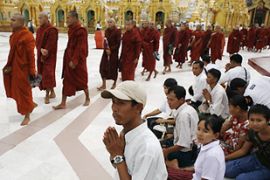Myanmar monks defy military threats
Soldiers and police are deployed after monks and sympathisers stage fresh protests.

“They are in full battle gear and they have shields and truncheons. Since two or three days, you could see they are rehearsing anti-riot formations,” a Southeast Asian diplomat said on condition of anonymity.
Government vehicles mounted with loudspeakers were reported to be cruising the streets of the city saying the clergy had been ordered not to take part in “secular affairs” and accusing certain elements of trying to instigate unrest.
The order cited a legal clause which would allow the protests “to be dispersed by military force”.
US sanctions
|
“I think all the people of Myanmar must act to get democracy for a better life” aprat_1992, Denpasar, Indonesia |
As the protests continued, George Bush, the US president, announced that Washington will tighten sanctions on Myanmar’s military government.
“This morning I’m announcing a series of steps to help bring peaceful change to [Myanmar],” Bush said in a speech to the UN General Assembly in New York on Tuesday.
“The United States will tighten economic sanctions on the leaders of the regime and their financial backers, and we will impose an expanded visa ban on those responsible for the most egregious violations of human rights as well as their family members.”
Suu Kyi greeted the monks as they passed, but police resumed guarding the entrance to the street soon afterwards.
| Myanmar protests |
The moves against the demonstrators come after Brigadier General Thura Myint Maung, Myanmar’s religious affairs minister, told Buddhist leaders that “action will be taken” to prevent further protests.
“We warn the monks and the people not to participate in protest marches. We will take action under the existing law,” he was quoted as saying.
Human rights groups reported on Monday that government agents had been preparing to infiltrate the protests in order to spark trouble and justify a crackdown.
‘Pretext for crackdown’
The London-based Burma Campaign UK said it had a received reports of soldiers ordered to shave their heads, apparently to pose as monks and infiltrate the protests.
“They would start rioting or attacking police, providing the regime with a pretext for a brutal crackdown on protesters,” the group said.
An estimated 50-100,000 protesters marched through the streets of Yangon on Monday in the biggest demonstration yet against the military government.
| Myanmar’s monks |
|
At some point in their lives, every Buddhist male is expected to join the monk hood or ‘Sangha’. Every village or neighbourhood has its own pagoda and monastery, which traditionally serves as the focus for community life and the main centre for education. In recent years rising levels of poverty have raised demand for the free education provided by the monasteries. |
“The protest is not merely for the well-being of people but also for monks struggling for democracy and for people to have an opportunity to determine their own future,” one monk told The Associated Press.
“People do not tolerate the military government any longer.”
The protests were initially triggered by a massive hike in the price of fuel on August 19, but have developed into a more deeply-rooted outpouring of dissent led by groups of monks.
In the space of a month the protests have become the biggest challenge to Myanmar‘s military government in almost two decades.
Charles Petrie of the United Nations’ Development Programme in Myanmar told Al Jazeera the demonstrations were an expression of the frustrations felt by many in the country after years of poverty and hardship.
“The monks have brought out into the open the issues that are of real concern to a significant portion of the population,” he said.
“There is an underlying suffering that is now being expressed.”

